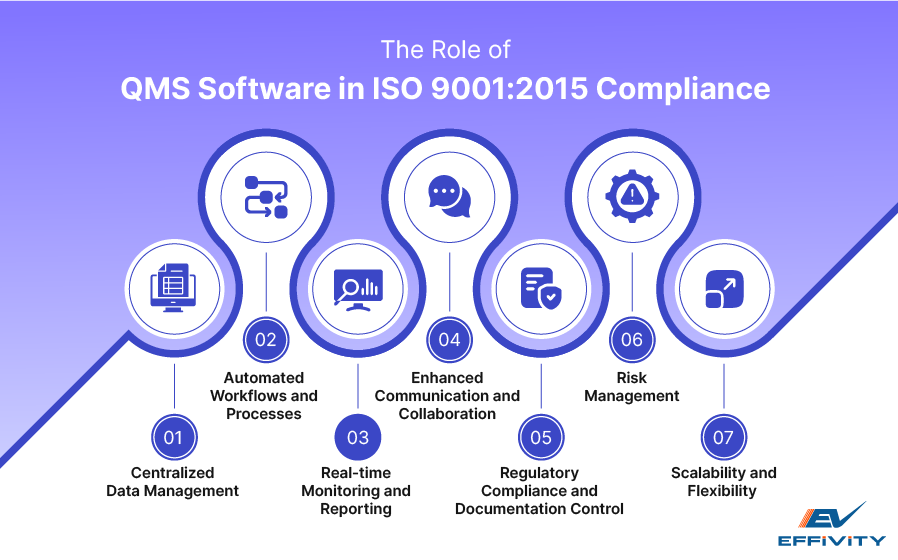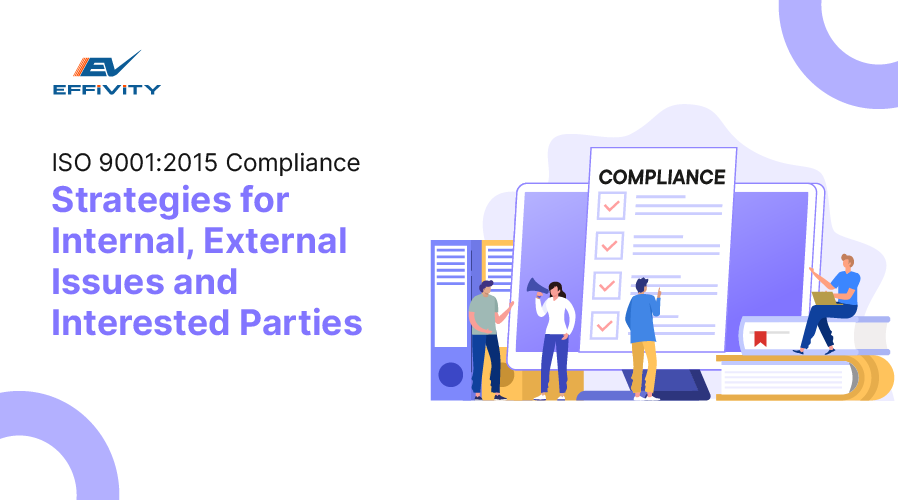Ever wondered who gets impacted by the decisions your company makes? While most businesses focus on systems to identify internal and external issues, very few focus on the broader impact of their decisions.
Standards such as the ISO holds organizations accountable with regards to their operational efficiency and ability to meet legal and regulatory requirements. ISO 9001:2015 is not just about identifying quality management challenges anymore. It also asks you to consider how your choices affect the people and groups connected to your business.
To be compliant, your ISO 9001:2015 compliance strategies must balance identifying internal and external issues and also cater to interested parties and stakeholders. In this blog, we will explore how to identify external and internal issues and manage the needs of interested parties through organizational frameworks and quality management software.
Context of the Organization
Understanding and implementing ISO 9001 context of the organization is an unavoidable part of compliance management. Defining your organizational context involves a thorough evaluation of both internal and external issues that influence your strategic objectives and QMS planning.
1. Internal and External Issues
Internal Factors
Your organization's internal context includes elements such as your corporate culture, organizational structure, governance and the technologies you employ. Strategic decisions and your vision for the future also fall under this category.
Internal factors dictate how your processes and responses are shaped. Understanding internal processes allows you to create an actionable quality management systems improvement plan.
External Factors
The external context of your organization includes everything outside your organization that can affect the ability of your organization to meet objectives. This includes
- Socio cultural trends
- Legal and political landscapes
- Economic climat
Let's say the government introduces a new regulation. You'll need to adjust your processes to stay compliant. Similarly, a bad economy could make things unpredictable, forcing you to rethink your strategy management.
2. Boundaries and Scope
The scope of your QMS must be clearly defined and should accurately reflect the purposes and strategic direction of your organization. It involves setting the boundaries within which the QMS operates and is a key step of QMS planning. In this case, you need to identify internal and external issues that may affect your operational efficiency.
At this stage, you would also define processes that are central to your QMS and determine how external influences and internal capabilities affect these processes.
If your business grows into new markets, your QMS needs to grow with it. This means understanding new regulations and figuring out how that market works.
Setting clear boundaries helps your QMS fully meet ISO 9001 standards while also effectively managing risks and opportunities.
3. Monitoring and Reviewing
To keep your Quality Management System strong, you need to check on it regularly and make updates as needed. These reviews should be based on a predefined frequency and must reflect your organization’s operating environment. For most organizations, reviews are annual, however, if your organization is rapidly evolving, you may want to consider more frequent reviews.
Integrating ISO 9001 risk assessment techniques during these evaluations helps in identifying potential risks and opportunities that could impact the effectiveness of your QMS. The review process helps to confirm that your QMS is equipped for handling both current and future challenges and enhancing organizational performance ISO 9001.
Interested Parties
1. Identification
A key step in ISO 9001 implementation is pinpointing everyone who has a stake in your company's success. This helps you tailor your Quality Management System to meet their specific needs. Stakeholders are anyone affected by your business.
This includes shareholders, government agencies, your own employees, suppliers, partners, lenders and even the community you're in. The scope of these identified interested parties is largely determined by the context you have previously defined for your organization.
For identification, you must consider how each group interacts with your organization. Shareholders might be focused on financial returns, while government bodies are concerned with compliance to regulations. Employees seek secure and rewarding work environments and customers demand reliable and quality products or services.
Understanding these needs and expectations clearly helps you define your QMS to address these specific requirements and enhancing organizational performance ISO 9001.
2. Needs and Expectations
Knowing what your stakeholders need and expect is key to making your QMS work, both now and in the future.Here’s how you can approach this:
- Debt holders typically expect financial stability and timely repayments.
- Suppliers seek assurance of consistent orders and timely payments.
- It's important for employees to feel they're getting a fair deal – this means good treatment, job security and reliable paychecks. They also often value opportunities to learn and a safe workspace.
- Customers want good products and services that do what they're supposed to. Happy customers are loyal customers and that's great for your reputation.
- Local Communities may expect your business to operate responsibly in their area and contribute positively to the local economy.
Each group's expectations must be systematically identified, documented and managed within your QMS. This understanding forms the basis of a quality management system improvement plan.
Role of QMS Software
Quality Management System software makes it easier to follow compliance processes under ISO 9001:2015. These software solutions help you keep track of internal and external issues and ensure that you can efficiently handle the needs and expectations of interested parties.

Here’s how QMS software implementation can help your organization
- QMS software is a central repository for all quality-related data and information. This centralized approach makes sure you always have the information you need to make good quality-related decisions.
- QMS software helps prevent mistakes and makes processes run more smoothly by taking care of repetitive tasks.
- QMS software lets you keep an eye on your quality goals and numbers as they happen. This feature enables your organizations to track performance continuously against your quality objectives.
- QMS software helps teams and departments work together more smoothly by providing clear communication channels.
- Keeping up with changing regulations is tough. QMS software makes it easier by helping you manage documents and stay on top of the latest standards.
- QMS software helps you spot and prevent problems before they happen with its built-in risk assessment tools.
Final Thoughts
ISO 9001 promotes an awareness of internal and external processes. Additionally, it stresses on the need to prioritize what your customers and partners need. This enhances compliance and operational performance.
To continually improve and manage risks well, you need a plan. This means knowing your company's goals, setting clear quality targets and regularly checking how you're doing. If you want to keep your quality system strong, QMS software is non-negotiable. It helps you stay on top of your compliance by managing data, documents and automating processes.






























